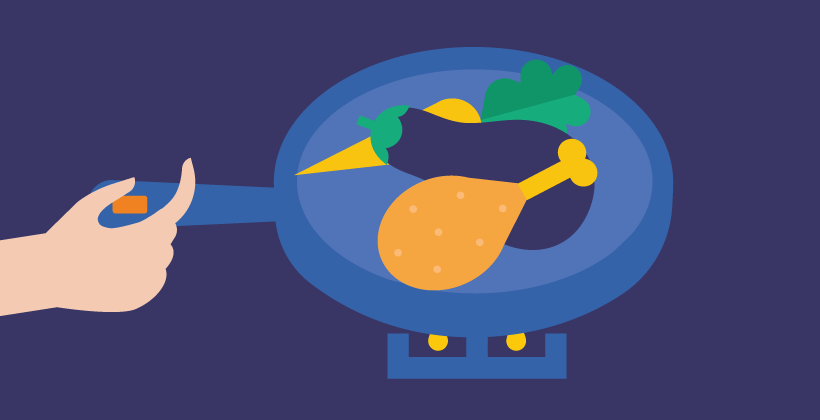What happens when we cook food? Understanding acrylamide formation
Last Updated : 31 October 2008Updated 11th June 2014 (Scroll to bottom of page for addendum)
For many thousands of years, people have used heat to cook foods. However, along with the formation of the desired flavour, odour and colour compounds, the process of heating can also lead to the formation of less favourable substances. One such compound that has received much scientific and media interest over recent years is acrylamide.
Discovery of acrylamide in food
Initially, acrylamide was only known for its uses in industrial processes such as in the production of plastics, glues, paper and cosmetics. Accidental exposure of workers to high levels of acrylamide led to the identification of the substance as a neurotoxin. This means that acrylamide at high doses has the ability to cause damage to the nervous tissue. In animals, high doses of the compound are known to cause cancer and affect reproduction.
In 2002, researchers from Stockholm University, Sweden, made the surprising finding of acrylamide formation in foods, and since then, acrylamide has been found in a range of foods processed at high temperatures.1 Acrylamide can be formed in foods during heating processes that reach temperatures of 120°C or higher e.g., frying, baking and roasting. French fries, potato crisps, biscuits and crackers, crispbreads, breakfast cereals, roast potatoes, bakery products and coffee were originally found to contain acrylamide. Further investigations have identified acrylamide in dried fruits, in baked vegetables, in black olives and some roasted nuts.
How is acrylamide formed in foods?
The formation of acrylamide in foods occurs as the result of a reaction known as the Maillard reaction, which is a chemical reaction between an amino acid (the building block of protein) and a sugar such as glucose, fructose or lactose.
Heat is required to start the cooking reaction that causes a cascade of chemical changes which ultimately result in the “browning” of the food and the formation of a range of odour and flavour compounds. Together these compounds give the characteristic appearance and flavour of cooked food. One of the most common examples of the Maillard reaction is the heating of white bread to give brown toast.
The formation of acrylamide itself is only partly understood as the Maillard reaction is one of the most complicated chemical reactions that occur in food. However, the formation and concentration of acrylamide in foods appears to be dependant on the type of food, the temperature and the length of time the food is heated. Generally, starchy foods (e.g., bread, potatoes) that have been cooked at higher temperatures and for longer periods of time contain increased levels of acrylamide.
As well as the cooking time and the cooking temperature, research has shown that levels of an amino acid known as asparagine are also linked to the formation of acrylamide. This particular amino acid has a chemical structure that is very similar to the chemical structure of acrylamide, which suggests that during the Maillard reaction, asparagine may be being converted into the acrylamide compound.
What levels of acrylamide are found in foods?
Scientists generally agree that the foods containing the highest levels of acrylamide are those that are fried, deep-fried or oven-baked, such as cake, bread and French fries. The Joint Expert Committee on Food Additives (JECFA) reports that the major contributing foods to total acrylamide intake for most countries are potato chips (16-30%), potato crisps (6-46%), coffee (13-39%), pastry and sweet biscuits (10-20%) and bread and rolls/toasts (10-30%).2
Other food items contribute less than 10% of the total. Intake of acrylamide within the EU varies between 0.3-1.4 micrograms per kg body weight per day, and contributions from individual types of food vary with national diets.3
No levels of acrylamide have been found to date in foods which have been boiled, poached or steamed. This may be explained by the maximum temperature of these techniques, which does not exceed 100°C, and by the absence of a browning reaction.
Is acrylamide in foods harmful to human health?
Shortly after the Swedish study, the former Scientific Committee on Food (SCF) issued an opinion on the potential human health concerns associated with acrylamide in food.4 The World Health Organisation (WHO) states that “acrylamide belongs to the group of chemicals thought to have no reliably identifiable ‘threshold’ of effects, meaning that very low concentrations will also result in very low risks, but not in zero risk”.5
In 2005, the European Food Safety Authority (EFSA) Panel on contaminants supported the conclusions of the JECFA report that efforts should be made to reduce exposure to the substance.2,6
In order to understand better the risks posed by cooking foods at high temperatures, the European Commission funded the HEATOX (Heat-generated Food Toxicants – Identification, Characterisation and Risk Minimalisation) project.3 The aims of HEATOX were to identify, characterise and minimise the risks posed by unfavourable compounds produced during the cooking process. In particular, it focused on acrylamide and in 2007 released four main findings based on laboratory experiments; 1) acrylamide in food might be a cancer risk factor; 2) it is possible to reduce levels of acrylamide formation in food, but not to eliminate it; 3) analytical methods to detect acrylamide in foods are available; and 4) cooking food may produce other compounds relevant to human health.
What is being done to reduce the levels of acrylamide in foods?
Food manufacturers have taken measures to reduce acrylamide formation in foods such as crispbread, baked goods/biscuits, and potato crisps by re-focussing quality controls, and changing recipes and cooking processes. It is important to note however that such processes cannot take into account the element of seasonality, which has a significant impact upon the content of acrylamide precursors in agricultural raw materials.
To collate the knowledge generated by the food industry, the Confederation of the Food and Drink Industries of the European Union (CIAA) has published an ‘Acrylamide Toolbox’, which provides steps that can be implemented by food manufacturers as well as by consumers at home to reduce acrylamide levels in their foods.7 Findings from the HEATOX research have been considered and included where feasible in the updated ‘Acrylamide Toolbox’ document.
Researchers are now looking at the possibility of reducing acrylamide levels in foods through blocking the reaction during cooking, through biotechnology and the adaptation of current farming techniques. For example, increasing the sulphur levels in soil and decreasing the levels of nitrogen have been shown to reduce the levels of acrylamide in some food crops. Furthermore, through the use of genetic modification, researchers have produced a new variety of potato altogether, which contains lower levels of sugar than standard potatoes.8 Decreasing the level of reducing sugars (e.g., glucose) in potatoes is likely to reduce the concentration of acrylamide as this type of sugar is a key component of the Maillard reaction, through which the unfavourable compound is formed. Similarly, genes are targeted within the plant that are responsible for controlling the levels of asparagine formation. As asparagine is another key component required for the formation of acrylamide, reducing the levels of the compound in the plant is likely to have a knock-on effect in reducing the formation of acrylamide during the Maillard reaction.
Benefits of cooking
In general, there are many benefits to cooking foods which must not be forgotten. In addition to increasing palatability and sensory appeal, thorough cooking reduces the risk of food poisoning. Furthermore, the process of cooking makes a number of essential nutrients more readily available so that it is easier for our bodies to use them.
What you can do
As research continues to identify ways to reduce the formation of acrylamide during the heating of some foods, consumers should avoid overcooking (excessive browning) of such foods. Following the cooking instructions on food packs and cooking equipment can help achieve this goal. In addition, consumers should aim to vary their cooking techniques to include more boiling, steaming and similar methods that help keep acrylamide formation to a minimum. As some of the products that can be high in acrylamide are also energy-dense, they should be eaten in moderation as part of a healthy balanced diet.
References
- Tareke E, Rydberg P, Karlsson P, Eriksson S, Törnqvist M. (2002) Analysis of acrylamide, a carcinogen formed in heated foodstuffs. Journal of Agricultural and Food Chemistry. 50(17):4998-5006. doi: 10.1021/jf020302f S0021-8561(02)00302-3
- JECFA Report TRS 930-JECFA 64/8.
- The HEATOX Project, Final Project Leaflet.
- Scientific Committee on Food (2002) Opinion of the Scientific Committee on Food on new findings regarding the presence of acrylamide in food.
- World Health Organisation (WHO). Food Safety section: Frequently asked questions - acrylamide in food.
- European Food Safety Authority, Key Topics section: Acrylamide in food.
- The CIAA Acrylamide ‘Toolbox’.
- Rommens CM, Ye J, Richael C, Swords K. (2006) Improving Potato Storage and Processing Characteristics through All-Native DNA Transformation. Journal of Agricultural and Food Chemistry 54(26):9882-9887. doi: 10.1021/jf062477l S0021-8561(06)02477-0
Addendum June 2014
The Confederation of the Food and Drink Industries of the European Union (CIAA) officially changed its name in June 2011 and is now known as FoodDrinkEurope (FDE).
The European research project HEATOX finished in November 2007. HEATOX findings fed into the FDE (formerly CIAA) Acrylamide Toolbox. The Toolbox is updated on a continuous basis as the science progresses.
In January 2014, FDE published a revised series of sector-specific pamphlets based on the Acrylamide Toolbox and available in 23 European languages. The pamphlets set out the latest tools to help Europe’s food and drink sectors mitigate Acrylamide formation in certain food products.
The latest report on acrylamide by Joint Experts Committee on Food Additives (JECFA) was published in 2011. It forms part of a JECFA evaluation of certain contaminants in food. JECFA reported that the major foods contributing to the total mean dietary exposures for most countries were potato chips (10–60%), potato crisps (10–22%), pastry and sweet biscuits (10–15%) and bread and rolls/toast (13–34%). Other food items contributed less than 10% to the total dietary exposures.
The European Commission (EC) made a Recommendation to Member States (2007/331/EC) in 2007 on the monitoring of acrylamide levels in food. The monitoring is targeted to those foodstuffs that are known to contain high acrylamide levels and those that contribute significantly to the human dietary intake.
In early 2011, the EC issued indicative levels for acrylamide in certain foods, based on European monitoring data. Indicative values are not safety thresholds. They are only intended to indicate the need for an investigation by relevant authorities, into why the level has been exceeded. These indicative values were updated in November 2013.
In 2012, European Food Safety Authority (EFSA) published European data on acrylamide levels in a variety of foods from 2007 to 2010. The data has been used as a measure of whether the strategies identified within the Toolbox approach have been successfully implemented by the European food industry. Evidence of the efficacy of the Toolbox approach taken by the food industry is important because it will inform future European member state discussions on their approach to the acrylamide issue. The European data reported the analysis of 10 different food categories, although some sample sizes of food categories were small for example for potato crisps. The study reported no significant decreasing trend in acrylamide levels in these crisps. Indicative acrylamide values recommended by the EC were exceeded in the case of 3-20 % of samples in different food categories based on 2010 monitoring data. The report concluded that an extended time period and detailed descriptions of sample sources would be needed for a more accurate trend evaluation.
A study published in 2013, reported on the analysis of a much larger dataset for acrylamide concentrations in potato crisps from 2002 to 2011 and showed that, in contrast to previous findings, a general trend of decreasing acrylamide levels over time was sustained throughout that period.
The European Food Safety Authority (EFSA) is currently carrying out an assessment on acrylamide and human health. The assessment will consider related international developments, including work by JECFA. The draft version is expected to be completed and open for public consultation in June 2014. The feedback received will assist in the final scientific opinion that is scheduled for 2015.
References
- FoodDrinkEurope, Acrylamide Pamphlets, January 2014. Available here (Accessed 22nd May, 2014).
- Evaluation of certain contaminants in food (Seventy-second report of the Joint FAO/WHO Expert Committee on Food Additives). WHO Technical Report Series, No. 959, 2011. Available here (Accessed 22nd May, 2014).
- European Commission Recommendation of 3 May 2007 on the monitoring of acrylamide levels in food (2007/331/EC). Available here (Accessed 23rd May, 2014).
- Commission recommendation of on investigations into the levels of acrylamide in food, Brussels, 10.1.2011 C(2010) 9681 final. Available here (Accessed 23rd May, 2014).
- European Food Safety Authority; Update on acrylamide levels in food from monitoring years 2007 to 2010, EFSA Journal 2012;10(10):2938. Available here (Accessed 23rd May, 2014).
- Powers et al. (2013) Acrylamide concentrations in potato crisps in Europe from 2002 to 2011, Food Additives & Contaminants: Part A, 2013. Available here (Accessed 23rd May, 2014).


